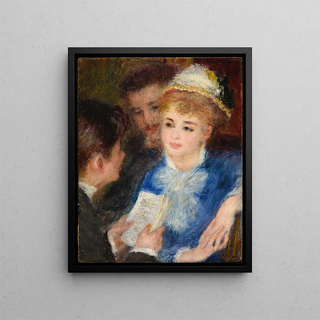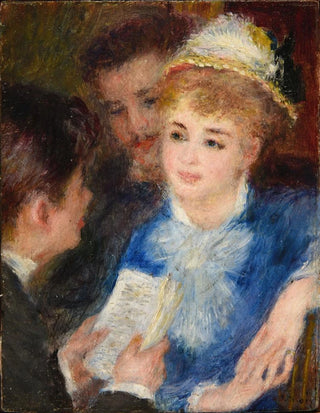Art print | La Lecture du rôle - Pierre-Auguste Renoir


View from behind

Frame (optional)
In the fascinating world of impressionist art, "The Reading of the Role" by Pierre-Auguste Renoir stands out for its delicacy and sensitivity. This artwork, created in 1874, immerses the viewer in a moment of intimate contemplation, where one can almost hear the whisper of the thoughts of the depicted characters. Renoir, master of light and color, manages to capture not only the physical appearance of his subjects but also the atmosphere of a scene that seems suspended in time. The scene takes place in an intimate setting, where a woman is engrossed in reading a role, while a man observes her with a mixture of tenderness and admiration. This piece invites reflection on the nature of art and life, where each brushstroke becomes an invitation to explore the nuances of human emotion.
Style and uniqueness of the work
Renoir's style in "The Reading of the Role" is emblematic of his impressionist approach, characterized by vibrant color strokes and diffuse light. The characters, although frozen in a reading posture, appear alive, almost animated by the brilliance of the surrounding colors. Renoir's technique, which involves layering paint to create depth and brilliance, gives this artwork an almost tactile dimension. The faces of the protagonists, delicately modeled, convey a range of emotions from concentration to tenderness. The play of light, filtered through the windows, adds a warm atmosphere to the scene, reinforcing the idea that art is a reflection of life, both fragile and ephemeral. Every detail, from the open book to the characters' clothing, is carefully thought out to create a visual harmony that captivates and enchants.
The artist and his influence
Pierre-Auguste Renoir, an emblematic figure of impressionism, knew how to mark his era with his unique vision of beauty and everyday life. Born in 1841, he evolved within a rapidly changing artistic context, where academic conventions were being challenged. Renoir established himself as an innovator, exploring diverse themes ranging from daily life

Matte finish

View from behind

Frame (optional)
In the fascinating world of impressionist art, "The Reading of the Role" by Pierre-Auguste Renoir stands out for its delicacy and sensitivity. This artwork, created in 1874, immerses the viewer in a moment of intimate contemplation, where one can almost hear the whisper of the thoughts of the depicted characters. Renoir, master of light and color, manages to capture not only the physical appearance of his subjects but also the atmosphere of a scene that seems suspended in time. The scene takes place in an intimate setting, where a woman is engrossed in reading a role, while a man observes her with a mixture of tenderness and admiration. This piece invites reflection on the nature of art and life, where each brushstroke becomes an invitation to explore the nuances of human emotion.
Style and uniqueness of the work
Renoir's style in "The Reading of the Role" is emblematic of his impressionist approach, characterized by vibrant color strokes and diffuse light. The characters, although frozen in a reading posture, appear alive, almost animated by the brilliance of the surrounding colors. Renoir's technique, which involves layering paint to create depth and brilliance, gives this artwork an almost tactile dimension. The faces of the protagonists, delicately modeled, convey a range of emotions from concentration to tenderness. The play of light, filtered through the windows, adds a warm atmosphere to the scene, reinforcing the idea that art is a reflection of life, both fragile and ephemeral. Every detail, from the open book to the characters' clothing, is carefully thought out to create a visual harmony that captivates and enchants.
The artist and his influence
Pierre-Auguste Renoir, an emblematic figure of impressionism, knew how to mark his era with his unique vision of beauty and everyday life. Born in 1841, he evolved within a rapidly changing artistic context, where academic conventions were being challenged. Renoir established himself as an innovator, exploring diverse themes ranging from daily life






